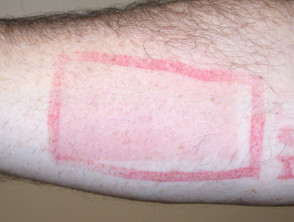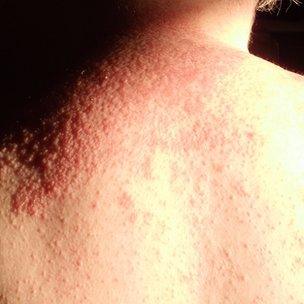
The immune system treats sun-altered skin as foreign cells leading to the reactions. The reactions that can occur include a rash blisters or hives.

If you are allergic to sunscreen chances are youre reacting either to one of the synthetic UV filters or a common allergen such as fragrance or preservatives.
Allergic reaction to sunscreen. With a sunscreen allergy you may experience any combination of. Rash Itching Stinging Burning Redness Bumps or irritation. According to Zeichner these are some signs of a sunscreen allergy.
Red skin Itching Swelling Rash Blisters that are filled with fluid. Allergic reaction to sunscreen makes it difficult to wear sunscreen. You will experience redness blisters and swelling immediately or a few days after applying your sunscreen.
It is because your skin reacts to the chemical components in the sunscreen or you. In some cases sunscreen allergy may cause a photocontact dermatitis in which the areas affected usually occur in a sun-exposed pattern on the body and where sunscreen has been applied. These areas often include the face arms backs of the hands V shaped area of the upper chest and lower neck.
Symptoms of sunscreen allergy This type of allergy usually manifests as a red itchy rash with bumps in the area you applied sunscreen. Usually it is a delayed rash as if you touched poison. It sounds as if you are experiencing a photo-allergic reaction or photocontact dermatitis meaning that the sunscreen product in combination with UVAB rays causes you develop an allergic reaction.
Oxybenzone benzophenone-3 the most widely used UVA blocking agent is the most common cause of sunscreen-induced photo-allergic contact dermatitis. A milder type known as irritant contact dermatitis involves redness or a stinging feeling where sunscreen was applied. An allergic reaction known as allergic contact dermatitis is rarer.
A sun allergy is a condition that happens when the immune system reacts to sunlight. The immune system treats sun-altered skin as foreign cells leading to the reactions. The reactions that can occur include a rash blisters or hives.
Only people with sensitivity to the sun will exhibit symptoms. The type of sunscreen allergy reaction can be contact photoallergy or allergic or irritant contact dermatitis. There are several symptoms of a sunscreen allergy depending on the severity.
The exposed area of skin may erupt in a red rash or bumps or a dry patch that is similar to a burn. A severe reaction can result in blisters and draining fluid. People with sensitive or allergy-prone skin should monitor how skin reacts after using sunscreen.
Signs that a product may be irritating the skin generally dont. Reactions to sunscreen are rare and can be a result of a sensitivity or allergy to any of the many ingredients used in these products. Some people may have a reaction to a fragrance preservative UV absorber or another component of the sunscreen.
Sensitivities to sunscreen are complex and can range from mild to severe. If you are allergic to sunscreen chances are youre reacting either to one of the synthetic UV filters or a common allergen such as fragrance or preservatives. Your best bet is to try a mineral sunscreen with as few ingredients as possible.
If that doesnt work sunlight may be the problem. Consult your doctor as soon as possible.